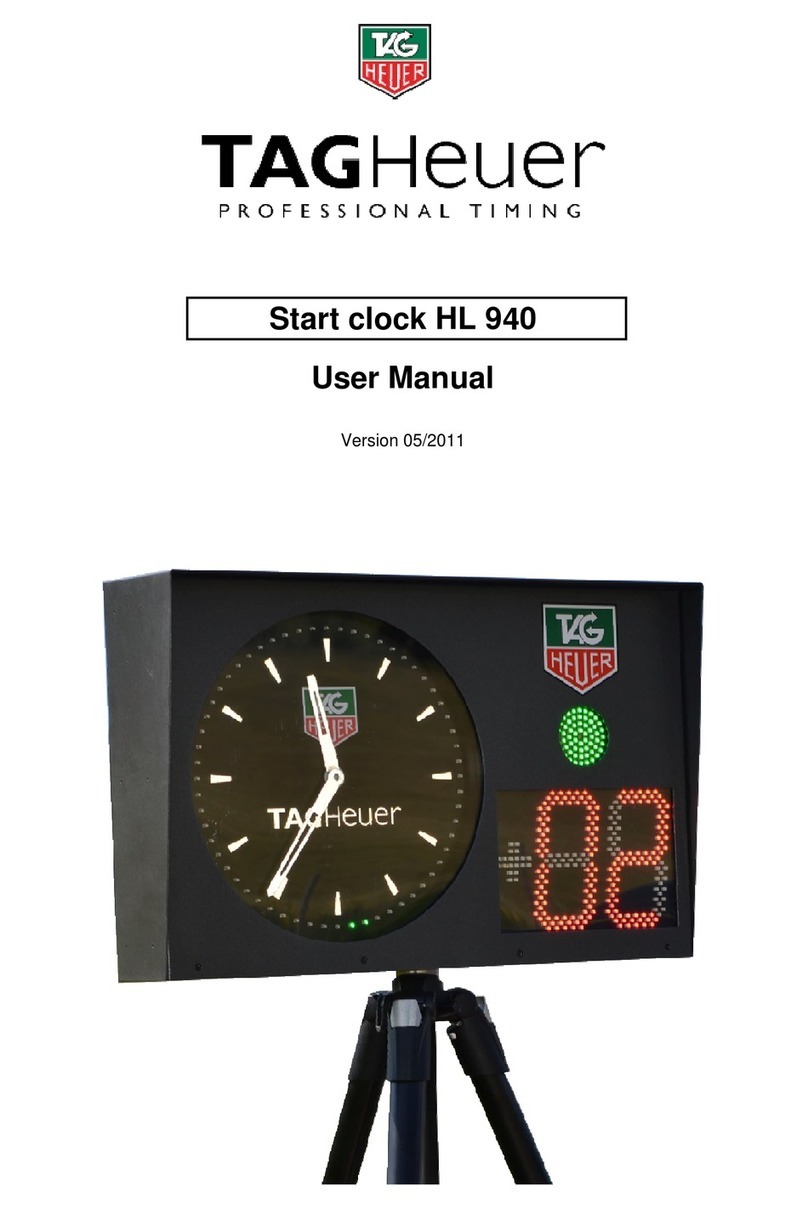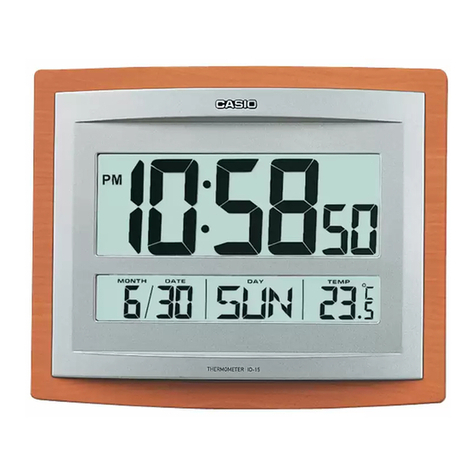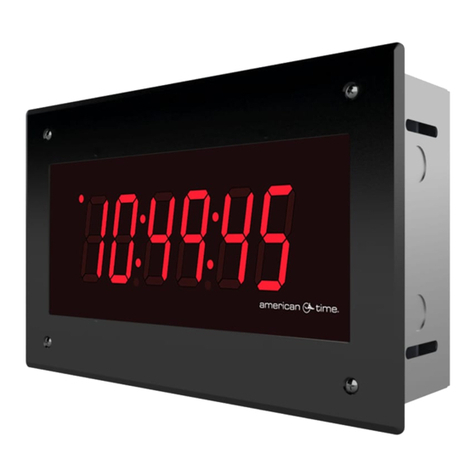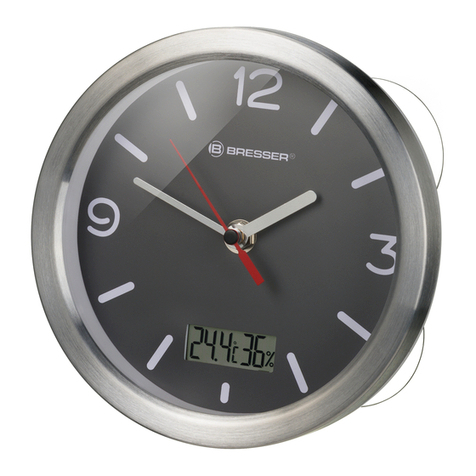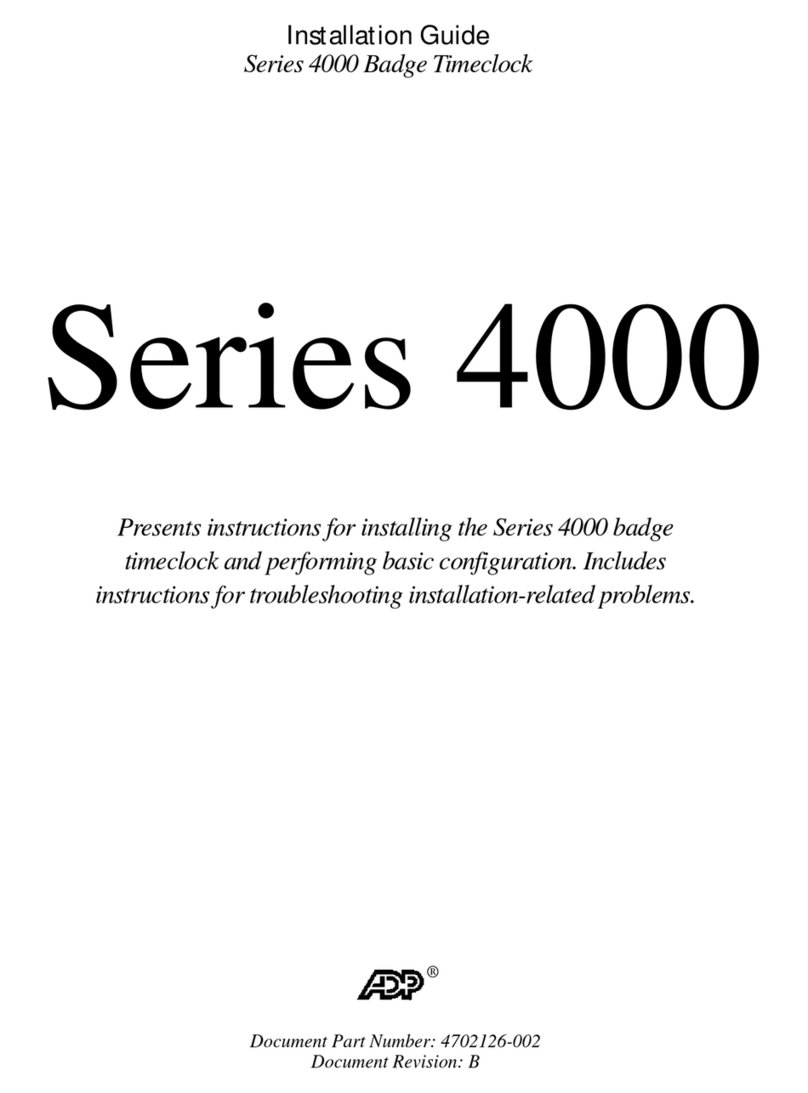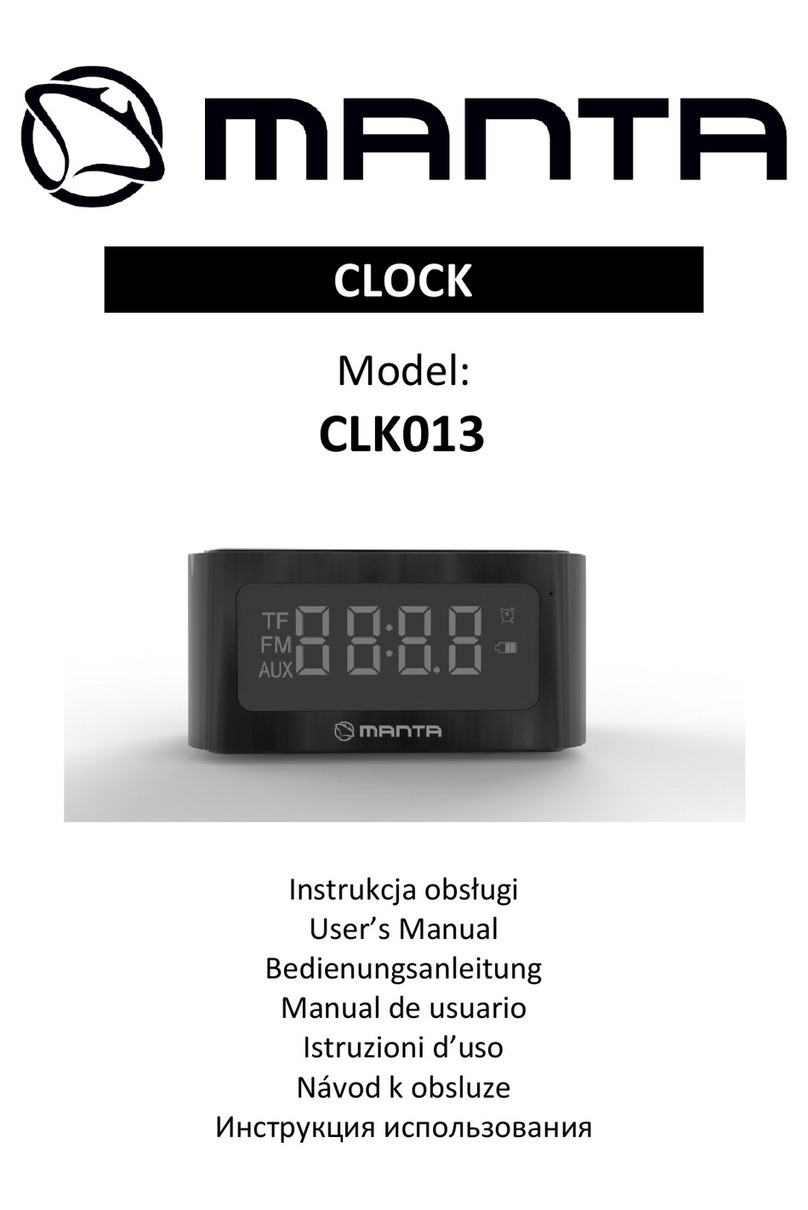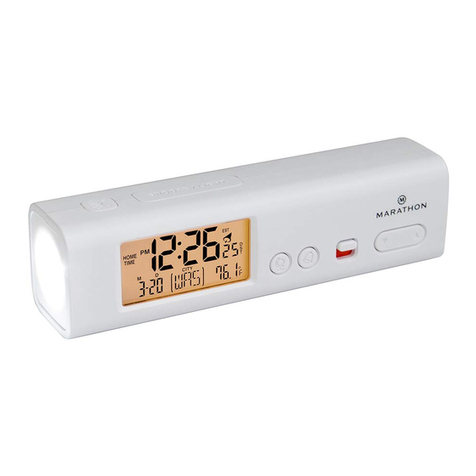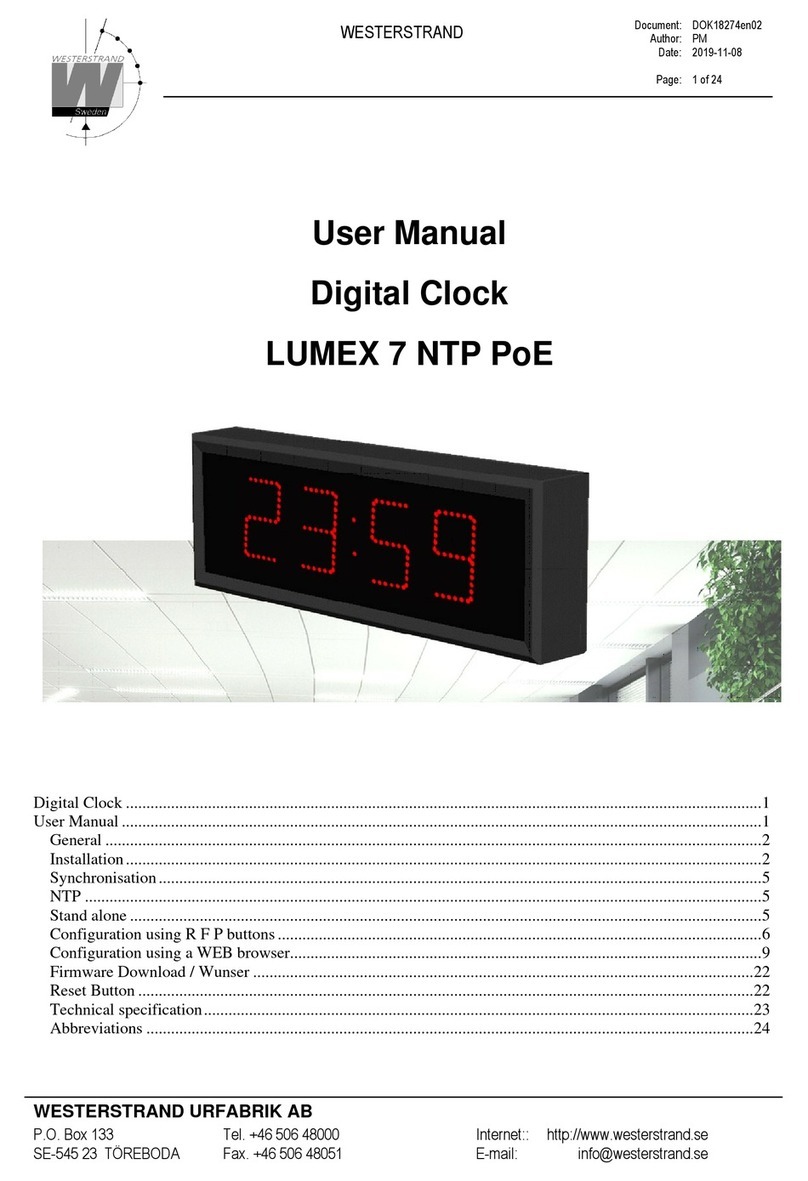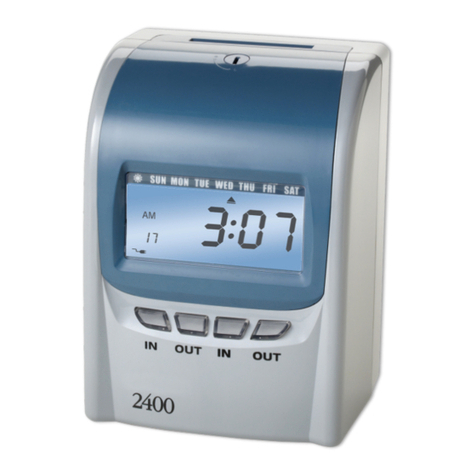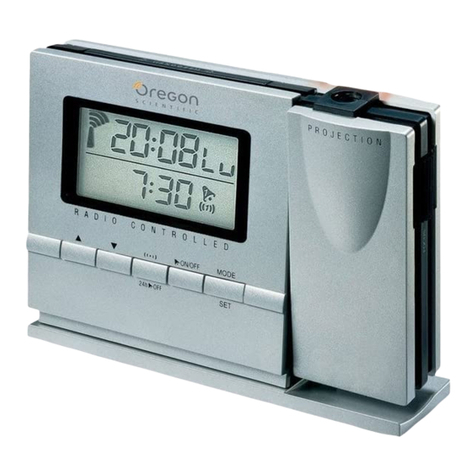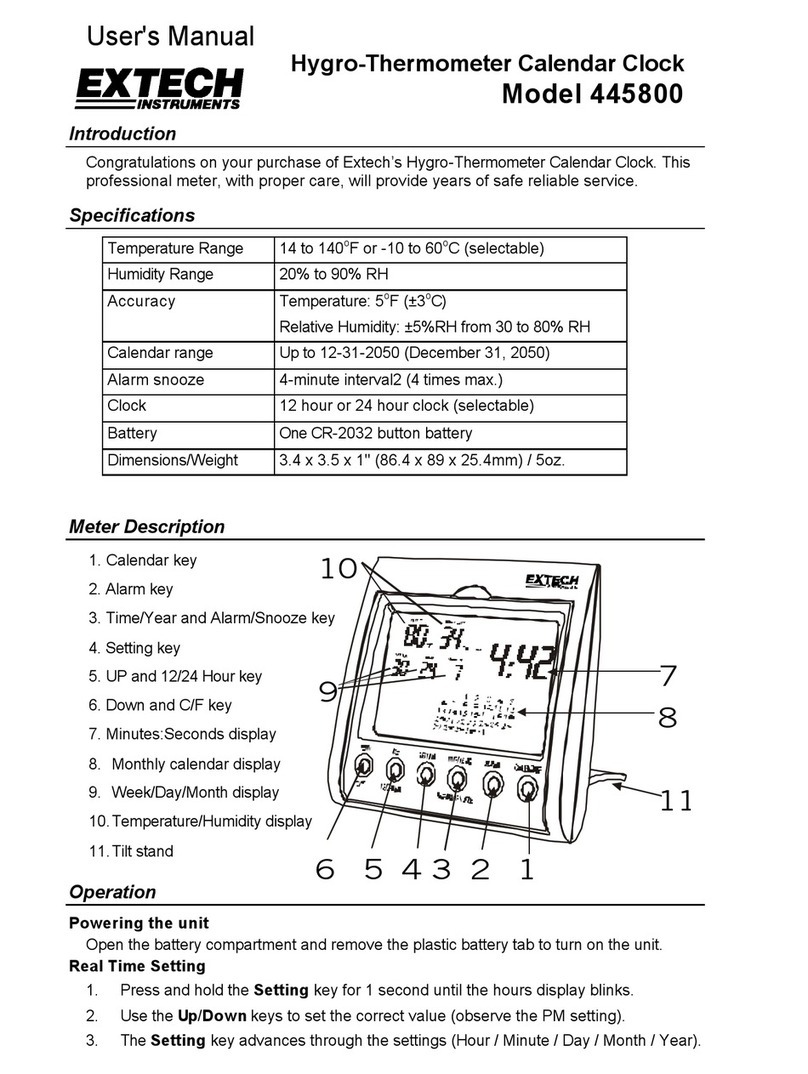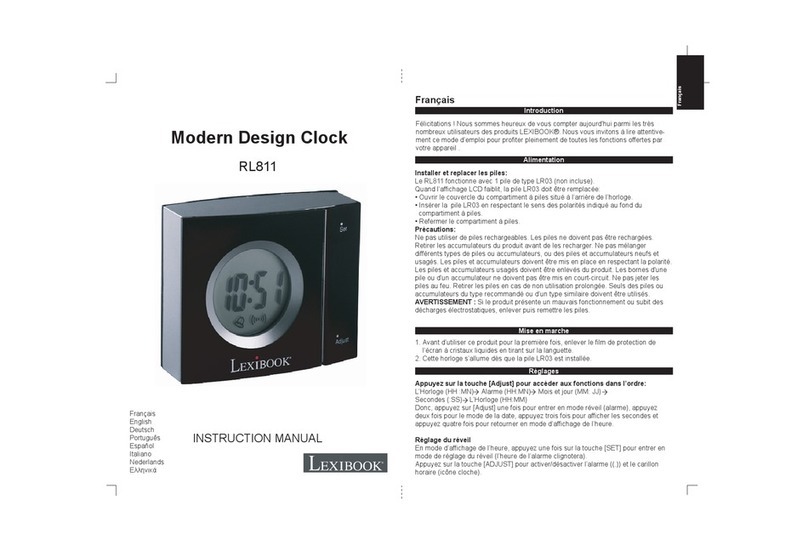Chelsea Mechanical Clocks Barometers User manual

Mechanical Clocks
Barometers
Since 1897
Owner’s Manual

Congratulations
You are the proud
owner of an
exquisite work of art,
crafted by the elite
master clockmakers
of Chelsea Clock. For
over a century, our
craftspeople have
been creating
instruments whose
beauty and
workmanship
enhance their
extraordinary
functionality and
durability.

Setting the Time
To set the time:
Remove black plastic tube from winding arbor
(save the tube and replace it when away for
extended periods of time or when shipping the
clock)
• Slowly turn minute hand (long hand) clockwise to cor-
rect time, stopping at each hour and half-hour point to
allow bells to strike fully (NOTE: The correct strike count
may not sound at the first strike point. This will self-
correct at the next full-hour point.)
Warning: The hour hand should never be moved manually;
only the minute hand. Never force hands. If they lock at
any point, turn the minute hand backwards through one
full striking, then continue as above.
Warn Periods
Mechanical clocks have a “warn” period at 20 minutes past
and 10 minutes before each hour. This means that, for the
10 minutes prior to each striking point, the gears and levers
of the mechanism are preparing to fall into position. There-
fore, when resetting the clock, only move the minute hand
clockwise to the next striking point and allow it to strike to
its full count before moving it again.
Warning: Never make adjustments during a strike zone;
only from 5 to 15 minutes past or 25 to 15 minutes before
the hour.

Winding the Clock
Please note that your new Chelsea Clock time-
piece leaves our factory fully wound.
The left keyhole on the dial is for winding the
strike mechanism; the right is for the clock’s
mainspring. Fully wind both weekly at approximately the
same time, starting with the left keyhole.
Warning: If the clock has run down completely, wind it first
before moving the hands. If the minute hand is locked, the
mechanism has jammed. To release: wind both sides, then
move the minute hand backwards one hour or more. Reset
the time, allowing full strikes at the hour and half-hour.
Regulating the Clock
Your clock is finely regulated before it leaves
our factory. However, environmental conditions
and other factors can affect its rate over time.
Adjusting the clock’s micrometer can help com-
pensate for minor time gains or loses
(wheel located on the left-hand side of the Ship’s Bell dial;
lever next to the “1” on the Shipstrike dial):
• Losing time? – Turn wheel/lever toward “F” (faster)
• Gaining time? – Turn wheel/lever toward “S” (slower)
Turning the wheel one notch in either direction changes the
rate approximately four seconds.
Tip: Let the clock run for a full week, then adjust the regula-
tor as needed.

Adjusting the Tone
The clear, resonant sound of a Chelsea Clock
chime occurs every time the strike hammer
drops onto its coiled steel gong. To strike prop-
erly, the clock must be in an upright position.
If, at any point, the strike sounds “flat” or fails to sound, the
hammer’s head may have become misaligned. You may
adjust it as follows, but first wait until it strikes the next full
hour:
• Access the strike mechanism by removing the back cover
(unscrew the three screws)
If the hammer is resting on, or is too close to, the gong, it
needs to be gently bent upwards – just enough so it’s not
touching the coil while at rest:
• Hold the wire between two ngers while in the rest posi-
tion (do not press down on it)
• Carefully bend the hammer slightly up and away from the
gong using needle-nose pliers or rigid object
• Using your nger, gently lift and drop the hammer wire to
hear its sound
• Repeat if necessary until the sound is clear and mellow
Note: This operation should only be performed on the hour
position, never on the half-hour.
Warning: If striking does not occur at the hour and half-hour
dial markings, the clock must be retuned to Chelsea Clock
for service.

Silencing the Chime
To silence the strike, simply slide the small pin
(located near the“8” on the Ship’s Bell dial,
and near the “11” on the Shipstrike dial) away
from the bell symbol. To resume striking, slide
the pin toward the bell.
Warning: Do not turn off the strike while the clock is strik-
ing. Be sure to move the pin completely in one direction or
the other to prevent jamming.
The Ship’s Bell Code
Mariners have used a unique bell code to tell time at sea
for hundreds of years. The code is based upon the crew’s
typical, 24-hour workday routine. The day is divided into
six four-hour periods, each called a “watch.” Similarly, the
crew is segmented into three divisions. Division members
perform their duties on two watches per day, with eight
hours off between watches. To rotate each division’s
watch times, the evening watch is typically divided into
two watches (called dogwatches). The first dogwatch is
the period between 4 and 6 p.m.; the second is the period
between 6 and 8 p.m.
First Watch 8:00 p.m. to 12:00 a.m.
Mid-Watch (also Black Watch) 12:00 a.m. to 4:00 a.m.
Morning Watch 4:00 a.m. to 8:00 a.m.
Forenoon Watch 8:00 a.m. to 12:00 p.m.
Afternoon Watch 12:00 p.m. to 4:00 p.m.
Evening Watch 4:00 p.m. to 8:00 p.m.

The Ship’s Bell Code, Cont.
The watch officer struck the ship’s bell every half hour to
apprise the crew of the time. A single bell sounded the end
of the first half hour, and one bell was added each half-
hour thereafter. Eight bells, therefore, signaled the end of
each four-hour watch.
The chimes of your Chelsea Clock timepiece reflect this
same traditional ship’s bell code:
8 bells 12:00 4:00 8:00
1 bell 12:30 4:30 8:30
2 bells 1:00 5:00 9:00
3 bells 1:30 5:30 9:30
4 bells 2:00 6:00 10:00
5 bells 2:30 6:30 10:30
6 bells 3:00 7:00 11:00
7 bells 3:30 7:30 11:30
The Barometer
How it Works
A barometer measures changes in atmospheric
pressure, or the “weight” of the air. Changes
in pressure typically foretell changes in the
weather. Weather watchers will note a barom-
eter’s reading and how much and how fast it
rises or falls. Rising pressure signals improving weather;
falling pressure indicates deteriorating conditions. Gener-
ally, a barometer works best when mounted indoors (away
from the elements) where air pressure is the same as that
outside.

Your Chelsea Clock barometer is an aneroid barometer,
meaning it measures atmospheric pressure without mercury
or other fluids. Instead it uses a vacuum and a hollow metal-
lic diaphragm. Pressure changes on the diaphragm cause
the dial’s black indicator hand to move. You can manually
position the gold hand over the black hand, and return later
to see whether pressure is rising or falling.
Barometers can measure pressure in inches, millibars or
centimeters. At sea level, normal atmospheric pressure is ap-
proximately 29.92 inches, 1014 millibars or 76 centimeters. At
higher elevations the average pressure will be less as there is
les air pressure overhead. Normal weather variations cause
pressure to rise or fall an inch or less, so you may see little
movement of the black hand for several days at a time. A
passing storm often brings rapidly falling pressure.
Setting for Local Altitude
When you Chelsea Clock barometer leaves our factory it is
adjusted to register pressure at sea level (the standard for
measuring barometric pressure regardless of location or
altitude). However, because atmospheric pressure decreases
as altitude increases, if you live in a higher-altitude location
you’ll need to adjust your barometer (corrected to sea level)
to receive an accurate reading. To do this, call your local
weather bureau and ask for the present barometer reading.
Adjust your barometer’s black indicator hand to the reading
given by turning the screw on the back of the case. If you
live at an altitude of 5,000 feet or greater, your barometer
should be adjusted professionally.
Tip: Before taking a reading, lightly tap on the barom-
eter glass to release any built-up frictional resistance on
the indicator dial.

Care & Service
Caring for Your Clock and Barometer
Case
Chelsea Clock cases are made of high
quality brass, superbly polished and
lacquered for long-lasting beauty and
protection. However, dust, fingerprints
and environmental pollutants may, over
time, mar the finish. To help maintain its
bright finish, we suggest cleaning the
case weekly with a clean, soft cloth. Never
use polishes, cleaners or other liquids, as
these can tarnish and pit the finish.
Servicing Your Clock or Barometer
Based on normal operating conditions,
our technicians recommend that your
Chelsea clock be cleaned, oiled and
adjusted about every seven years. Condi-
tions such as extreme heat, cold, dust and
prolonged idleness can necessitate more
frequent servicing.
Your Chelsea Clock timepiece or ba-
rometer is a precision instrument and
should only be serviced by a certified
repair technician. We suggest returning
your item to our factory repair center for
guaranteed service by an experienced,
Chelsea technician. Find repair details
online at www.ChelseaClock.com.

Limited Warranty
A new Chelsea Clock Ship’s Bell Clock or barometer is
warranted against defects in material and workmanship
for five (5) years from the date of original purchase; a
Shipstrike is warranted for two (2) years. In the event
of any such defect, please return the instrument post-
age prepaid, along with an explanation of the defect to
the address below and it will be repaired or replaced,
at our option and our expense. Any defect or damage
caused by misuse, accident, tampering or negligence of
the user is not covered by this warranty. Be certain to
carefully and securely pack the instrument for return.
We will not be responsible for damage in shipment. The
repaired or replacement instrument will be returned to
you postage prepaid. All implied warranties covering
merchantability, fitness for particular purpose, or oth-
erwise are limited in duration to five (5) years from the
date of original purchase for a Ship’s Bell; two (2) years
for a Shipstrike. The repair or replacement of any defect
is the exclusive remedy under this warranty. In addi-
tion, the warrantor shall not, under any circumstances,
be liable or responsible hereunder for consequential,
incidental, indirect or special damages. Please note that
some states do not allow limitations on how long an
implied warranty lasts, or the exclusion may not apply
to you. This warranty gives you specific legal rights; you
may have other rights that vary from state to state.
284 Everett Avenue, Chelsea, Massachusetts 02150
www.ChelseaClock.com
e: Repairs@ChelseaClock.com
p: 617•884•0250
f: 617•884•8639
Table of contents
Other Chelsea Clock manuals



